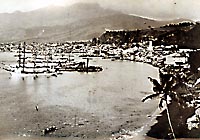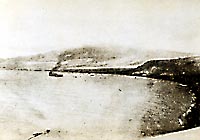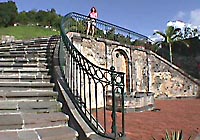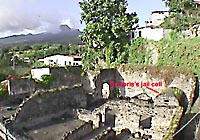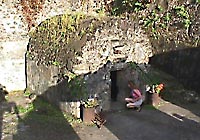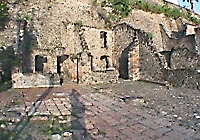 |
|||||||||||||||||||||||||
We started our search for the ruins of St. Pierre at the Volcanology Museum. Here we saw pictures of how St. Pierre looked before Mont Pele's eruption. St. Pierre was a big, beautiful and exciting city. St. Pierre was the center for trade in the Caribbean. St. Pierre traded with North America, South America, Europe and other Caribbean islands. Your great-grandparents (or great-great-grandparents) probably ate bananas and pineapples that came from St. Pierre. On May 8, 1902, at 7:50 am, the eruption of Mont PelÈe instantly wiped out this prosperous city of 30,000 men, women and children. The museum has on displays some of the things that were found after St. Pierre was destroyed, such as melted candles, melted glass, melted knives, forks, and spoons, melted globs of nails, melted guns, and a large, crushed church bell. The weirdest things that were found after the destruction of the city were black petrified food items(similar to petrified wood) such as loaves of bread and rice. After walking through the museum we looked around town for ruins from the eruption. St. Pierre has rebuilt over and around the ruins of the old city, so finding some of the ruins took some looking. Our first stop was the center of social life in St. Pierre, the Theater. The Theater could seat 800 people and was the most beautiful theater in all of North America, South America and the Caribbean. Even though the Theater was made of heavy blocks of stone, it was knocked flat by the explosive force of the eruption's hot, fiery winds. Most of what remains today are the curved stone stairways and the fountain at the front of the Theater. The thing we wanted to see most was right next to the Theater! Down at the base of the foundation wall of the Theatre wall was the jail cell where the only survivor from the eruption was found. A man named Sylbaris had been put in jail overnight and the thick walls of the jail cell were what saved his life. We ended our exploration of St. Pierre down along the waterfront. Here we found the ruins of shops and warehouses where ships' cargoes passed to and from St. Pierre. Clothing, tools, and machinery came in from Europe and sugar, molasses, rum, pineapples and bananas went out. All that remains now are some of the walls and stairs that lead to nowhere. Tomorrow we are going to from St. Pierre's waterfront out into the harbor to look for ships that were sunk by Mont PelÈe's eruption. We will be using our underwater scooters for the first time on the expedition. We will have to be careful because we will be scuba diving down below 150 feet underwater. This is about the maximum depth our scooters can go without being crushed. |
St. Pierre as it looked before the 1902 eruption. Compare this photo to the photo we took of St. Pierre yesterday.
St. Pierre just after the eruption of May 8, 1902.
Karen stands at the top of the stone stairs that were at the entrance of the Theater in St. Pierre.
Sylbaris's cell in the ruins of the city jail, next to the Theater. Sylbaris was placed in a small holding cell at the base of the Theater foundation.
Karen looks into Sylbaris's jail cell. We could see how Sylbaris was protected by the volcano's fiery gases, because the cell walls are about 3 feet thick!
Along the waterfront we find the ruins of stores and warehouses. Find Wayne's shadow as he takes this picture. |
||||||||||||||||||||||||
home | basecamp | archives | other expeditions | kids' page | contact us © 2001, The Ocean Adventure All rights reserved. |
